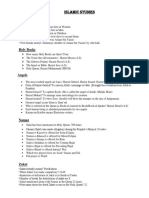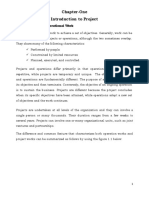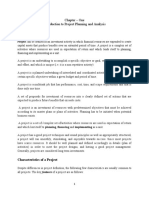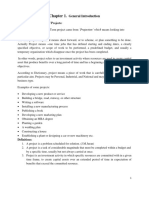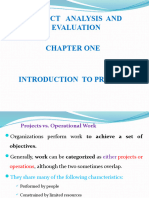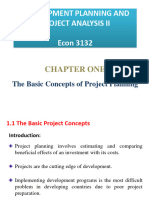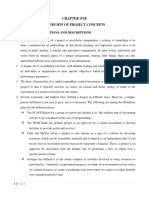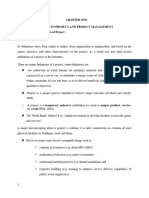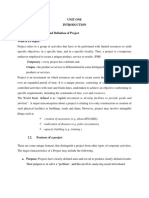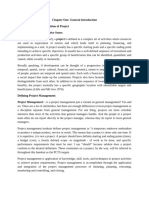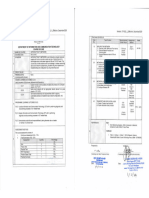Chapter 01 PM
Chapter 01 PM
Uploaded by
Hayelom Tadesse GebreCopyright:
Available Formats
Chapter 01 PM
Chapter 01 PM
Uploaded by
Hayelom Tadesse GebreOriginal Description:
Copyright
Available Formats
Share this document
Did you find this document useful?
Is this content inappropriate?
Copyright:
Available Formats
Chapter 01 PM
Chapter 01 PM
Uploaded by
Hayelom Tadesse GebreCopyright:
Available Formats
Chapter One
Introduction
1.1. What is a project?
Organizations perform work. Work generally could be classified into either operations or
projects, although in some cases both of them may overlap. Both operations and projects share
many characteristics in common like:
People perform both the activities.
Both are constrained by limited resources.
Both are planned, executed, and controlled.
However, operations and projects differ primarily in their repeatability. Operations are ongoing
and repetitive whereas projects are temporary and unique.
A project is a unique endeavor to produce a set of deliverables within clearly specified time, cost
and quality constraints.
Projects are different from standard business operational activities as they:
Are unique in nature: They don’t involve repetitive processes. Every project undertaken
is different from the last, whereas operational activities often involve undertaking
repetitive (identical) process.
Have a defined timescale: projects have a clearly specified start and end date within
which the deliverables must be produced to meet specified customer requirement.
Have an approved budget: projects are allocated a level of financial expenditure within
which the deliverables must be produced to meet specified customer requirement.
Have limited resources: at the start of a project an agreed amount of labor, equipment
and materials is allocated to the project.
Involve an element of risk: projects entail a level of uncertainty and therefore carry
business risk.
Achieve beneficial change: the purpose of a project, typically, is to improve an
organization through the implementation of business change.
For many organizations, projects are a means to respond to requests that cannot be addressed
within the organization’s normal operational limits.
Lecture note for Project Analysis and Management Page 1
Projects are undertaken at all levels of the organization. They may involve a single person or
many thousands. Their duration ranges from a few weeks to a few years.
Projects may involve a single unit of one organization or may cross-organizational boundaries.
As projects are often implemented as a means of achieving an organization’s strategic plan they
are critical for the organizations growth. Examples of projects could include:
Developing a new product or service.
Effecting a change in structure, staffing, or style of an organization.
Developing a new or modified information system.
Implementing a new business procedure or process.
Project management is the application of knowledge, skills, tools, and techniques to project
activities to meet project requirements.
Project management is accomplished through the use of the following 5 processes:
Initiation
Planning
Execution
Controlling and
Closure
1.2. Features of a project
Projects are classified based on several criteria, including: ownership, source of finance,
and forces behind the projects.
1. Based on ownership:
a. Private sector- mostly projects undertaken by business enterprises.
b. Public sector- projects undertaken by national and local government bodies.
c. NGOs- development projects are most often undertaken by non-government and non-
for profit organizations.
2. Based on the Sources of Finance:
a. Government treasury- projects may be entirely financed by government budget as
per its priority. For instance, construction of regional airport.
b. Government treasury and external sources- most projects are financed by the joint
partnership of the government and donor groups. For example, a road project may be
financed 50% by the government and 50% by a foreign donor.
Lecture note for Project Analysis and Management Page 2
c. External sources of Finance- projects may be financed totally by parties other than
the government but established for the well being of the citizens and the ownership
may be for the government or the public.
3. Based on the forces Behind:
a. Demand driven/need driven- based on identified unsatisfied demand project can be
created or on unsatisfied basic needs like food, water and shelter.
b. Donor driven- the force behind the financing organization. Donors will have their
own say and influence the types of projects to be established.
c. Political Driven- Projects may be established in response to some political situation
such as for example because of national elections, projects by religious organizations.
4. Based on their nature:
a. Civil engineering, construction, petrochemical, mining, quarrying, projects far away
from the contractor’s home office, and involve special risk as well as problems of
organizational communication.
b. Manufacturing projects- conducted in a factory or other home based environment
and enable exercising on the spot management.
c. Research projects- established for pure research consuming large sum of money and
lasting over years resulting in dramatic profitable discovery or proving waste of
money.
d. Management projects- projects that require the employment of an external project
manager or managing contractor for issues such as relocating head quarters,
developing and introducing a new computer system, preparing for a trade exhibition,
producing a feasibility or other study report, restructuring the organization etc.
Project exhibits the following basic characteristics.
1. A project involves the investment of scarce resources in the expectation of future benefits;
2. The project will have a measurable Objectives. Projects have specific of benefits that can
be identified, quantified and valued, either socially or monetarily/commercially/.
3. Related to the specificity of objectives, the projects have specific beneficiaries or clientele
group, which needs to be specifically spelt out during project planning studies.
4. A project is the smallest operational element unit. A project can be planned, financed and
implemented as a unit. Often projects are the subject of special financial arrangements and
have their own management.
5. The boundaries of projects make them distinguishable from each other.
Projects are conceptually bounded. The problem and specific objective (need) that
justify the project involves conceptual delimitations.
Lecture note for Project Analysis and Management Page 3
Projects are geographically bounded. Projects exist in space and we say that projects
are geographically (locationally) bounded.
6.
Projects are organizationally bounded. Projects require the establishment of a special
organization or the crossing of traditional organizational boundaries, meaning there
should be certain organizational unit responsible for project implementation.
Projects are time bounded. One factor that makes projects bounded is the time (life
cycle) of a project. Projects have specific lifetime, with a specific start and end time in
which a clearly defined set of objectives are expected to be achieved.
7. Uncertainty and risks is inherent in any project. Achieving project objectives cannot be
predicted in advance with accuracy. The factors that make project risk are:
Significant and multiple types of scarce resources committed today
expecting outcome in the future;
Benefits are expected to be generated in the future, which is less
predictable;
Capital investments are irreversible; therefore, perfect exit
assumption of the perfect competition model is refuted.
8. It has a scope that can be categorized into definable tasks. Projects usually have well defined
sequence of investment and production activities
9. It may require the use of multiple resources. This has an implication on management of
project implementation. The more diverse the types of resources are mobilized the more
complex will the management be. The outcome of project and hence development endeavor
is sensitive to the management of each type of resources. Ill managed resource can contribute
more to cost than to benefit.
1.3. Project and Plan
Planning can be defined as a “continuous process that involves decisions or choices about
alternative ways of using available resources with the aim of achieving a particular goal or set
of goals at some time in the future.”
The rationale for planning is that it serves as a tool that enhances the effectiveness in mobilizing
resources and enables allocation of resources into priority areas of development. In this regard,
Lecture note for Project Analysis and Management Page 4
development planning can be regarded as an attempt to raise the rationality of decision-making.
The hierarchical relationship among development plans, programs, tasks, and work packages is
depicted below:
Development Plans
Programs
Projects
Tasks
Work Packages
Figure: Hierarchical Relationships
It is necessary to distinguish between projects and programs because there is sometimes a
tendency to use them interchangeably. A project refers to an investment activity where resources
are used to create capital assets, which produce benefits over time and has a beginning and an
end with specific objectives, while a program is an ongoing development effort (plan) involving
a number of projects. Programs may or may not necessarily be time bounded. Yet programs
cannot live forever, they have limited life cycle, which however, may or may not be explicitly
stated. So in effect in terms of time delimitation, there is only relative difference between
programs and projects. For instance, a health program may include a water project as well as
Lecture note for Project Analysis and Management Page 5
construction of a health center; both aimed at improving the health of a given community that
previously lacked easy access to these essential facilities.
Note that projects can stand alone without being part of certain program. So, one can visualize
that the linkage of policies, development plans, and projects. Projects, which are not linked with
others to form a program, are sometimes referred to as “stand alone” projects.
Development plans:
Most forward looking (futuristic)
Broad and require systematic thinking, preparation and appraisal
Attempts to bring welfare in the society
Programs:
Derived from development plans
Exceptionally large with long term objectives
Explores specific area with broader scope
Projects:
Derived from a program
Unique investigative tool
A development activity with specific objectives
Funded by a program
An implementation element (entity)
Tasks:
Work elements under a project
Specific approaches for doing things
Set of activities comprising a project
Work packages:
Sub elements of a given task (or undertaking)
Something accomplished stage by stage
Collection of work packages defines a given task
Lecture note for Project Analysis and Management Page 6
As it can be observed from the above framework, in general, the essence of development
planning is futuristic, i.e., it is most forward looking and involves systematic thought and
preparation. Virtually, every nation, be it developed or developing, should have a systematically
elaborated national plan to hasten economic growth and further a range of social objectives.
Therefore:
1. Projects provide an important means by which investment and other development
expenditures foreseen in plans can be clarified and realized. Sound development plans
require good projects, just as good projects require sound planning. The two are
interdependent.
2. A sound plan requires a great deal of knowledge about existing and potential projects.
Sound planning rests on the availability of a wide range of information about existing and
potential investments and their likely effects on growth and other national objectives.
Thus, plans require projects. Realistic planning involves knowing the amount that can be
spent on development activities each year and the resources that will be required for
particular kind of project.
3. Effective project preparation and analysis must be set in the framework of a broader
development plan. Projects are part of an overall development strategy and a broader
planning process.
4. The more elaborated the plans and policies of the governments are, the easier becomes
the work of the project planner. For example, the project planner will have to refer to
such plans and policies to see whether the project being considered fits well in the plan
and contributes most to the fundamental objectives of the government. These objectives
can include self-sustaining growth, promotion of employment, income distribution, etc.
5. As projects rightly called the “Cutting Edge” of development, they are powerful means
to achieve the development objectives; they are the crucial building blocks of a
development structure.
6. Projects aim mainly at increasing the production of goods and services, which are
fundamental components of people’s welfare, and the main objective of any development
effort is, of course, to advance social well-being.
Differences:
PROJECTS PROGRAMS
Lecture note for Project Analysis and Management Page 7
specific objectives General objectives
Specific project areas No specific project areas
Specific beneficiaries group No Specific beneficiaries group
Clearly determined and allocated funds No clear and detailed financial resource allocation
Specific lifetime No specific lifetime
Similarities:
Projects and programs have similar characteristics in a way that both are:
Having objectives;
Requiring financial, human, material, etc inputs (or resources);
Generating outputs, (goods/services), of value;
Serving as instruments for the execution of development plans in order to boost the
national economy.
Lecture note for Project Analysis and Management Page 8
You might also like
- Introduction To Physiological/Biological PsychologyDocument4 pagesIntroduction To Physiological/Biological PsychologyMerry100% (1)
- The FavorDocument11 pagesThe FavorGwen DentNo ratings yet
- Exam 2 Managerial Accounting CH 4-6Document29 pagesExam 2 Managerial Accounting CH 4-6kotisanampudiNo ratings yet
- Islamic Studies Cometitive Exam Key PointsDocument6 pagesIslamic Studies Cometitive Exam Key PointskhalidNo ratings yet
- Project MGT ModuleDocument93 pagesProject MGT ModulederejeNo ratings yet
- Chapter OneDocument10 pagesChapter Onedemeketeme2013No ratings yet
- Chapter OneDocument25 pagesChapter Onemekibib fisihaNo ratings yet
- Chapter 2 ProjectDocument17 pagesChapter 2 ProjectbihonegnNo ratings yet
- PROJECT PLANNING (GaDs-451)Document72 pagesPROJECT PLANNING (GaDs-451)zenebe agbachewNo ratings yet
- Chapter One: Project Analysis and EvaluationDocument23 pagesChapter One: Project Analysis and EvaluationBadhaasaa Abbaa BilisummaaNo ratings yet
- Chapter-One General Introduction: Projects vs. Operational WorkDocument12 pagesChapter-One General Introduction: Projects vs. Operational WorkAnonymous WYQyWTlhHNo ratings yet
- BPM 412 NotesDocument13 pagesBPM 412 NotesMark OnyangoNo ratings yet
- Chapter One PMDocument7 pagesChapter One PMadinew abeyNo ratings yet
- PROJECT PLANNING (GaDs-451Document73 pagesPROJECT PLANNING (GaDs-451Jemal SeidNo ratings yet
- Project Chapter 1 HighDocument6 pagesProject Chapter 1 Highbeth elNo ratings yet
- SMART Project Handout Print 2024Document55 pagesSMART Project Handout Print 2024Shalle said AdenNo ratings yet
- Project Mgtchapter 1&2 For StudentsDocument12 pagesProject Mgtchapter 1&2 For StudentsMeron TemisNo ratings yet
- Project ManagemetDocument34 pagesProject Managemetmekashaabebe245No ratings yet
- PM Unit-1Document9 pagesPM Unit-1shivani123409No ratings yet
- Project PPT - Ch-1 ModifiedDocument48 pagesProject PPT - Ch-1 Modifiedfarhan abdiNo ratings yet
- Project CH 1Document10 pagesProject CH 1Kal KalNo ratings yet
- Chapter 1 PM BA - 075917Document12 pagesChapter 1 PM BA - 075917chuchuelu9No ratings yet
- Project PptDocument270 pagesProject PptsilabatNo ratings yet
- Planning II Chapter IDocument118 pagesPlanning II Chapter ItarkulamisoNo ratings yet
- Chapter OneDocument33 pagesChapter OnemishamomanedoNo ratings yet
- Project ManagementDocument40 pagesProject Managementtanvir nahidNo ratings yet
- project hundoutDocument68 pagesproject hundoutTomorrow SonNo ratings yet
- It ProjectDocument5 pagesIt ProjectPoachan Binyiti DanielNo ratings yet
- CH 1Document14 pagesCH 1Amanuel HabtamuNo ratings yet
- Project Planning and Management CHPTR 1Document17 pagesProject Planning and Management CHPTR 1akmaljihad75No ratings yet
- PM CH-1Document32 pagesPM CH-1Addaa WondimeNo ratings yet
- Chap1 EconometricsDocument14 pagesChap1 EconometricsAbrham MengistuNo ratings yet
- PDF P.MDocument86 pagesPDF P.MEyael ShimleasNo ratings yet
- abchDocument70 pagesabchRejalNo ratings yet
- Project Appraisal and Management SuggestionDocument56 pagesProject Appraisal and Management Suggestionsharifulmd2021No ratings yet
- Chapter 1Document5 pagesChapter 1Mõ HãzàrdNo ratings yet
- 1Document17 pages1Adane AbebeNo ratings yet
- Mbad 782 Project Management NotesDocument75 pagesMbad 782 Project Management NotesKevin ManyaraNo ratings yet
- Abdihakim PCM AssignmentDocument25 pagesAbdihakim PCM Assignmentnajkoz yaruNo ratings yet
- ch 1 projectDocument9 pagesch 1 projectmohammedjemal941No ratings yet
- IM 05 Project ManagementDocument69 pagesIM 05 Project ManagementBurtukan EdaoNo ratings yet
- Chapter One Introduction To Project and Project Management 1.1 Meaning and Definition of ProjectDocument10 pagesChapter One Introduction To Project and Project Management 1.1 Meaning and Definition of ProjectyeshiwasdagnewNo ratings yet
- Project Management CH 1Document7 pagesProject Management CH 1meklitgashawNo ratings yet
- Unit OneDocument8 pagesUnit OneBirhex FeyeNo ratings yet
- MANAGING HR PROJECTDocument17 pagesMANAGING HR PROJECToriedo96No ratings yet
- Develo 1Document265 pagesDevelo 1Amare SimachewNo ratings yet
- Project Management-NotesDocument61 pagesProject Management-NotesAkhilesh MauryaNo ratings yet
- Chapter I IntroductionDocument21 pagesChapter I IntroductionLee HailuNo ratings yet
- Tom Mboya Labor College: DSCM 3: Project and Contracts Management/ DPM 2: Project Procurement ManagementDocument33 pagesTom Mboya Labor College: DSCM 3: Project and Contracts Management/ DPM 2: Project Procurement Managementjoshua omondiNo ratings yet
- Project MGT PDFDocument46 pagesProject MGT PDFmasudrana 90No ratings yet
- Project Identification and FormulationDocument11 pagesProject Identification and FormulationTrinath MajhiNo ratings yet
- Chapter One-ProjectDocument13 pagesChapter One-ProjectAdugnaNo ratings yet
- MGT PpaDocument97 pagesMGT Ppaderzer2020No ratings yet
- Chapter 1 (1) Chapter One: General IntroductionDocument16 pagesChapter 1 (1) Chapter One: General IntroductionWondmageneUrgessaNo ratings yet
- HBC 2404 Project MGT Final.Document21 pagesHBC 2404 Project MGT Final.Yimnai C.YNo ratings yet
- Project Management 1 EMBA JnUDocument12 pagesProject Management 1 EMBA JnUShamima AkterNo ratings yet
- Project ManagementDocument58 pagesProject Managementskspankaj08No ratings yet
- Module 1Document13 pagesModule 1anshikasinha9812No ratings yet
- Project AllDocument162 pagesProject AllBEALU GIRMAYENo ratings yet
- Project MGT & An 1-75Document77 pagesProject MGT & An 1-75demeketeme2013No ratings yet
- Chapter 1 Introduction To IT Project ManagementDocument8 pagesChapter 1 Introduction To IT Project ManagementHussen MossaNo ratings yet
- Project 1&2Document9 pagesProject 1&2Tafa TuluNo ratings yet
- Principles of Dispute ResolutionDocument8 pagesPrinciples of Dispute ResolutionHayelom Tadesse GebreNo ratings yet
- Cont Public WorksDocument24 pagesCont Public WorksHayelom Tadesse GebreNo ratings yet
- Construction Laws and RegulationsDocument12 pagesConstruction Laws and RegulationsHayelom Tadesse GebreNo ratings yet
- Chapter 4 InventoryDocument29 pagesChapter 4 InventoryHayelom Tadesse Gebre100% (1)
- Outline: Definition and InterpretationDocument31 pagesOutline: Definition and InterpretationHayelom Tadesse Gebre100% (1)
- Procurement Law (International) : UncitralDocument52 pagesProcurement Law (International) : UncitralHayelom Tadesse GebreNo ratings yet
- The Fidic Provisions With Their Short Messages: Taken FromDocument48 pagesThe Fidic Provisions With Their Short Messages: Taken FromHayelom Tadesse GebreNo ratings yet
- FormofcontractDocument79 pagesFormofcontractHayelom Tadesse GebreNo ratings yet
- Chapter Three Construction ContractDocument109 pagesChapter Three Construction ContractHayelom Tadesse GebreNo ratings yet
- Introduction To The Construction IndustryDocument30 pagesIntroduction To The Construction IndustryHayelom Tadesse GebreNo ratings yet
- FIDIC Vs MOWUDDocument26 pagesFIDIC Vs MOWUDHayelom Tadesse Gebre100% (4)
- Contractors Master List 1994-2001 Registered: Registred 1994 - 2001Document2 pagesContractors Master List 1994-2001 Registered: Registred 1994 - 2001Hayelom Tadesse GebreNo ratings yet
- New Red B. Harmonised ForDocument19 pagesNew Red B. Harmonised ForHayelom Tadesse GebreNo ratings yet
- Part3 NoteDocument28 pagesPart3 NoteHayelom Tadesse GebreNo ratings yet
- Overveiw FIDICDocument16 pagesOverveiw FIDICHayelom Tadesse GebreNo ratings yet
- Procurement and Contracting Practices in ConstructionDocument41 pagesProcurement and Contracting Practices in ConstructionHayelom Tadesse GebreNo ratings yet
- Ppa of Contruct DocumentDocument18 pagesPpa of Contruct DocumentHayelom Tadesse GebreNo ratings yet
- Project Delivery Mechanisms: Inadequate Quality ControlDocument18 pagesProject Delivery Mechanisms: Inadequate Quality ControlHayelom Tadesse GebreNo ratings yet
- Procurement and Contracting Practices in ConstructionDocument41 pagesProcurement and Contracting Practices in ConstructionHayelom Tadesse GebreNo ratings yet
- UNCITRAL Arbitration RulesDocument6 pagesUNCITRAL Arbitration RulesHayelom Tadesse GebreNo ratings yet
- The Legal Regulation of Construction ProjectsDocument41 pagesThe Legal Regulation of Construction ProjectsHayelom Tadesse GebreNo ratings yet
- Taxation Philippine Tax and Income System Assignments and QuizdocxDocument20 pagesTaxation Philippine Tax and Income System Assignments and QuizdocxMicaella ShayneNo ratings yet
- Rodzssen Supply Co Inc V Far East Bank and Trust CoDocument4 pagesRodzssen Supply Co Inc V Far East Bank and Trust CoJanine Oliva100% (2)
- BinaryDocument4 pagesBinaryPrince Rudy DoctoleroNo ratings yet
- Eemaan, Ibaadah and TawheedDocument10 pagesEemaan, Ibaadah and TawheedMOHAMAD HANIM BIN MOHAMAD ISANo ratings yet
- Case Study FinalDocument29 pagesCase Study FinalStefPerNo ratings yet
- PlumbingDocument7 pagesPlumbingstephen riveraNo ratings yet
- Module in Tstrat 4Document3 pagesModule in Tstrat 4Jera ObsinaNo ratings yet
- FTC4 CHAPTER 4 Components of Special and Inclusive EducationDocument32 pagesFTC4 CHAPTER 4 Components of Special and Inclusive EducationKaren CaballesNo ratings yet
- Enveronment 3Document17 pagesEnveronment 3Lestari AgustinaNo ratings yet
- Hooper Appointment Referral PacketDocument8 pagesHooper Appointment Referral PacketJustin RolnickNo ratings yet
- How To Pass The FCPS Part 1 Exam in ENTDocument4 pagesHow To Pass The FCPS Part 1 Exam in ENTDoodNo ratings yet
- 2018 ks2 Mathematics Paper3 Reasoning PDFDocument24 pages2018 ks2 Mathematics Paper3 Reasoning PDFAK2024No ratings yet
- Sales Manager ResumeDocument8 pagesSales Manager Resumee7d8e9bw100% (1)
- CALLP - Chapter 2 (Major Theories of Human Development)Document60 pagesCALLP - Chapter 2 (Major Theories of Human Development)Jbp PrintshopNo ratings yet
- Flaw ListDocument30 pagesFlaw ListLaouali DJARIRINo ratings yet
- Activity Worksheet 2 PDFDocument1 pageActivity Worksheet 2 PDFHps XgrmNo ratings yet
- Project On Toothpaste - Image Profile Analysis of Leading Brand ToothpastesDocument47 pagesProject On Toothpaste - Image Profile Analysis of Leading Brand Toothpastesshah faisal68% (37)
- Co ItnDocument1 pageCo ItndanieshaemNo ratings yet
- Sugar Manufacturing Process - Brief Introduction SlidesDocument52 pagesSugar Manufacturing Process - Brief Introduction Slideskiller120No ratings yet
- 9119-595 Sales ManualDocument185 pages9119-595 Sales Manualpacolopez888No ratings yet
- Service ContractsDocument35 pagesService Contractsnsrinivas0850% (2)
- OooDocument69 pagesOookomalNo ratings yet
- Harry Potter PoA Book ReviewDocument4 pagesHarry Potter PoA Book Reviewmohammadibraheems2006No ratings yet
- Organic Chemistry, Second Edition Janice Gorzynski Smith, ch3Document29 pagesOrganic Chemistry, Second Edition Janice Gorzynski Smith, ch3sungyeon heoNo ratings yet
- CH 10 I Grabbed The Leash of The Blind Beast - Read at WuxiaWorldEUDocument1 pageCH 10 I Grabbed The Leash of The Blind Beast - Read at WuxiaWorldEUndia6902No ratings yet
- Logbook Format 400 Fall16Document2 pagesLogbook Format 400 Fall16Katie KingNo ratings yet



